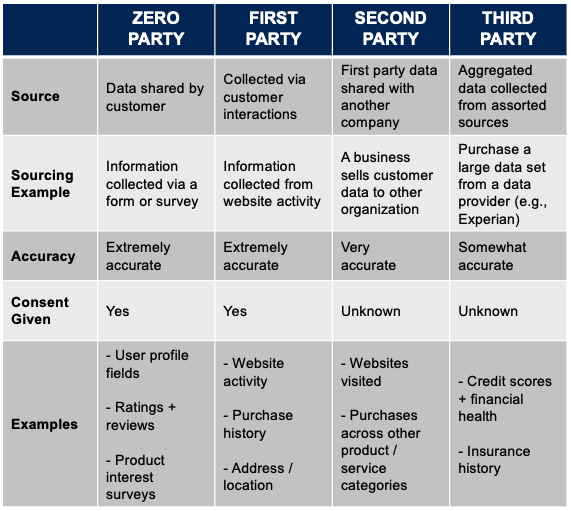Capturing customer data is no longer a “set it and forget it” mechanism. With everything from government regulations to customer expectations driving when and how data can be collected, organizations must be increasingly thoughtful about where they source data.
Enter zero party data. As a rich source of data direct from customers, zero party data avoids compliance and data protection issues while offering access to better, more reliable information.
Zero party data removes issues of data privacy and consent, all while giving organizations the rich intel they need to drive informed growth.
What Is Zero Party Data
Zero party data refers to data that customers or individuals willingly and knowingly give to an organization. With zero party data, there is no passive sharing of data from the individual to the organization. Rather, individuals actively give their information to others.
Why would customers do this? Because there is something in it for them.
Imagine a shoe brand asking about a customer’s preference for sandals versus loafers. Or, a B2B SaaS company asking about the specific types of market or category information that is of interest to someone. When customers give this information, companies can deliver more personalized recommendations or information.
Customers get what they want, and therefore feel more connected to the business. And, in turn, businesses get more engaged audiences.
Zero Party Data Versus Other Types Of Data
We cannot talk about zero party data without understanding how it differs from other data types.
First Party Data
First party data is data collected about customers as these individuals engage with a company’s websites, apps, or other digital properties. This means gathering information such as website pages seen, time on site, and website visit frequency.
The big distinction between first party and zero party data is the idea of active versus passive sharing. Often collected via cookies, first party data is collected while individuals engage in the company’s properties. They may have consented to the data collection. But they are not actively providing the data.

Second Party Data
Second party data is similar to first party data. It is information collected from an individual’s behaviors. But, it it then sold to another organization.
In this case, individuals may or may not know that their information is shared with another party.
Third Party Data
Third party data is data collected by organizations that often do not engage with users directly. They aggregate data collected across sources and then sell this data in packages. A common example of a third party data provider is Experian, an organization which pulls data from public records, financial sources, and other data repositories.
Once again, individuals likely have very limited visibility into what is happening with their data. Additionally, because data is aggregated across many sources, it is never as accurate as first or second party data.
The Value Of First Party Data Over Other Data Sources
Zero party data is so valuable because of how it is sourced. That is, unlike other data types, it comes directly from your customers with their complete knowledge that it is being collected. This means that unlike other data, zero party data is…
- Consent-Driven
- Extremely Reliable
- Extremely Accuracy
Let’s look at several ways you can use zero party data to see why these three value-points are so important.
Product Development
Gaining direct feedback from your customers on what features and products they actually want is the ideal way to fuel your product roadmap. It may result in new products that were not on your radar. Or, it may help prioritize which products or features make the final cut.
This process shows a customer-centric approach to product development that yields stronger engagement, satisfaction, and retention.
Marketing Promotions
Gathering zero party data lets you tailor marketing and product promotions to exactly what customers say they want. This means your messaging will hit the mark and be more likely to get them to buy.
Additionally, offering strongly resonating promotions will lead customers to keep an eye out for your messaging in the future. And, therefore, lead to more sales for you in the future.
Content Marketing
When customers (or potential customers) tell you what they want to learn more about, it’s your cue to give it to them. Collecting zero party data lets you create blog posts, ebooks, infographics, webinars, and other types of content your audience will care about.
This lets you drive engagement while building credibility as a trusted resource. Over time, you’ll see acquisition and retention numbers grow.
Zero Party Data Collection Options
There are a wide range of ways to collect zero party data. But, regardless of which approach you take, it should feel effortless to consumers. The questions you ask, how you ask them, and where you ask them should feel like a natural extension of your brand and where customers are in your funnel or business lifecycle.
Just a few ways to collect zero party data include:
- Post Purchase Surveys
- In App Question Pop Ups
- Registration Sign Up Form Fields
- Check Out Form Fields
You’ll note the list above includes specific places to capture data. In can be while browsing, while completing a purchase, after completing a purchase, or somewhere else. Be sure to match your questions to the customer’s experience at that point in time. This improves their willingness to share information and makes it feel like a seamless extension of their experience.






